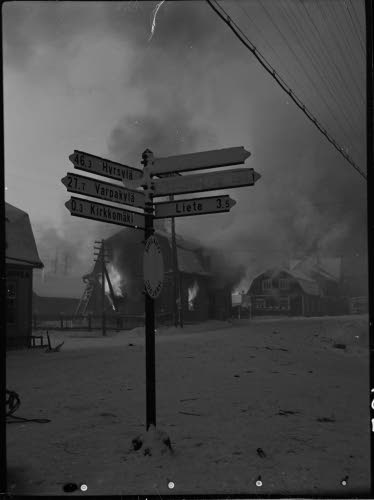Every nation has
defining moments in its history, but few have such a powerful single
event that embodies the people and spirit of the nation as Winter War
is for Finland. The war forged a nation divided by a bloody war of independence into one entity that stood with grim determination against hopeless
odds and survived to tell the tale.
 |
| Finnish troops fighting in the Arctic wilderness |
Before the Russian
invasion that begun on the 30th of November in 1939, most Finns
were blissfully unaware of the forces Stalin had assigned for what he
expected to be an easy victory. The Red Army had devised a plan to
attack Finland along the whole 1300 km long border with 21 divisions
that had 450 000 men.
 |
| Russian DB bomber shot down by the Finnish Air-Force |
Soviets highlighted
the totalitarian nature of their invasion already on the first day of the war as bomber
formations unleashed hell upon Finnish cities. It’s still somewhat
debated whether the attacks on civilian population were intentional
or a result of utter incompetence and failed targeting of the bombing
runs. The Soviet air-power had one powerful effect, the
whole Finnish nation understood that they were fighting for their
survival.
 |
| Burning village along the border |
The words of the marching song, written by the Nobel prize winning author F.E. Sillanpää put
the feelings of the men into words:
Siis te lapset ja vanhukset,
ja te äidit ja morsiamet,
niin kauan teillä on suojattu lies
kun on pystyssä yksikin mies.
Children and elders,
mothers and brides,
stove in your home shall be safe,
as long as there is a man standing
 |
| Finnish evacuated civilians at the Helsinki railway station, just minutes before the first bombing in 30th of Nov. |
Another important thing that made the situation feel like the army was fighting for everyone was the fact all civilians that could be evacuated from the front lines were moved to safety and looked after. Resettling hundreds of thousands of Finns was an extraordinary feat.
For the first few
days the Red Army advanced rapidly as the Finnish conscript and
Border Guard units fought a pre-planned delaying action. This short
phase allowed th made the situation feele Finnish forces to become accustomed to war and also
confirmed the amount of men, tanks and artillery the Red Army had was
significantly higher than expected, especially in the Northern
Finland where Finns weren’t expecting any major operations.
The Soviet use of
tanks and armored cars became as a shock to the Finnish troops, whose
anti-tank weaponry was scarce. The initial attacks routed the Finnish
forces, but with experience the confidence of the defenders grew.
With gained confidence and the realization that the few at-guns
available together with artillery, mines and improvised explosives
could actually defeat the steel beasts, the Finns set to work.
 |
| Captured Soviet 45mm AT-gun turned against its former owners |
 |
| Soviet BT-7 tank captured by the Finns |
Work, that’s what
the soldiers did, it wasn’t an adventure, it wasn’t a chance for
glory. Instead the war was grim, dirty, freezing and brutal work.
Something you undertake because it’s your duty, because everything you love is in danger.
While the spirit of
the work was the same, the actual war was very different along different parts of the long front. On the southernmost part of the front line, the
Karelian-Isthmus, the war transfomed into a one-sided trench warfare.
The Red Army hammered the Finnish defenses time after time with
frontal attacks supported by tanks, artillery and bombers.
 |
| Finnish soldiers holding captured British made Lewis-guns |
On the northern
battlefields the Red Army was restricted to operating along the
narrow roads that were few and far in between. This allowed Finnish
forces to stop numerically larger formations with smaller units and
eventually to encircle and destroy several Russian divisions by flanking them
with ski-troops.
In all theaters the skills and courage of the Finnish soldiers clearly outmatched the Soviet forces. While the superior marksmanship and the ability to ski were important, the biggest difference between the two forces was the difference in leadership. The Finnish troops were allowed to improvise and make tactical decision at all levels, on the other hand the Soviets operated in an extremely rigid chain of command.
From the beginning
of the war, Finland had mobilized both the army, its supporting civil
guard militias and womens voluntary organization Lotta Svärd. These
combined with women replacing reservists in various duties from
factories to forestry allowed the rather isolated country to remain
functional despite the heavy fighting and Russian air-raids.
 |
| Finnish women working at a munitions factory |
 |
| A Lotta working as an aircraft spotter in the freezing winter |
 |
| Lotta's working as HQ messenger |
The stiff Finnish
resistance forced Moscow to ultimately commit over 760 000 men, 6500
tanks and 3800 airplanes against a nation of only 3,5 million people. In the it was just a war of attrition that nearly depleted both sides, but with smaller resources Finland was forced to hand over most of Karelia to USSR. Despite a nominal victory and enough lands to bury the 1700 00 dead
Soviet soldiers and go gather their thousand knocked out tanks, the humiliation was unbearable for Stalin.
What can we learn
from the Winter War
War doesn’t need
one man, it requires every man and woman rallied around a common
cause.
Survival and duty
motivate far better than fear or glory.
Quality can
outmaneuver and outgun quantity.
Moscow will always lie.
Here are my earlier pieces on the Winter War:


Reading about the Winter War really resonates with me. It's incredible how a nation can come together in times of need, much like when I see communities rallying during file property tax protests. It's all about unity and standing up for what matters.
ReplyDelete